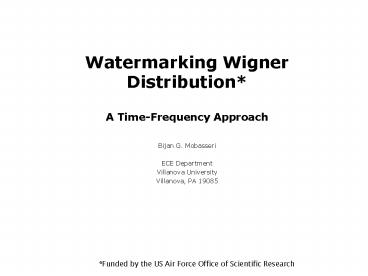Watermarking Wigner Distribution A TimeFrequency Approach - PowerPoint PPT Presentation
1 / 25
Title:
Watermarking Wigner Distribution A TimeFrequency Approach
Description:
4x4 blocks, each carrying one bit. 21 /25. Results. 22 /25. Data hiding in saturation ... A new transform domain for watermarking is introduced ... – PowerPoint PPT presentation
Number of Views:114
Avg rating:3.0/5.0
Title: Watermarking Wigner Distribution A TimeFrequency Approach
1
Watermarking Wigner DistributionA
Time-Frequency Approach
- Bijan G. Mobasseri
- ECE Department
- Villanova University
- Villanova, PA 19085
Funded by the US Air Force Office of Scientific
Research
2
Outline
- Motivation
- Time-frequency distributions
- Wigner distribution
- Watermarking model
- Embedding and detection
- Capacity
- Future work
3
Motivation
- Digital watermarking has heretofore been applied
in either spectral or temporal/spatial domains
but not in both simultaneously. - The ability to watermark joint time-frequency
cells provides additional control, capacity and
security
distinct keys
4
Time-varying data hiding
- Watermarking of time-frequency distributions can
follow a trajectory in time-frequency plane,
potentially complicating steganalysis efforts - Attacks with known T-F signatures can be
circumvented - An N-point signal has N2 TF distribution cells. A
substantial fraction is available for watermarking
f
t
5
Previous work
- The following is most likely the only work which
follows a similar concept. - S. Stankovic, I. Djurovic, I. Pitas,
Watermarking in the space/spatial-frequency
domain using two-dimensional Radon-Wigner
distribution, IEEE Transaction on Image
Processing, vol. 10, no. 4, pp.650-658, April
2001. - They add a sinusoidal pattern to the image in a
way that is only detectable in time-frequency
domain
6
Generating TFDWigner Distribution
- WD of function x is Fourier transform of its
local autocorrelation function. The Discrete-time
WD for a -D signal is given below
7
WD at work
8
Watermarking model
- We parallel DCT watermarking by additively
modifying selected T-F cells of WD. - This simple model will not work unless certain
precautions are taken into account
9
The Inverse Wigner
- Not every two dimensional function is an allowed
time-frequency representation - It is possible that no signal may be found that
has the given TFD - This is a synthesis problem and can be stated as
follows - Given a target (watermarked) WD, find the
corresponding signal x whose Wigner distribution
is closest to Y in some sense
10
Setting up the problem
?2HM ?1
?2
f2
?
?2? ?2
?1Mf1
f1
M
?
C(1)
?1Mf1
R(2)
?inadmissible
?admissible Mmapping function Htransformation
11
Solutions
- There are a number of solutions to this problem.
- For DTWD
- V. Kumar et al, Discrete Wigner synthesis,
Signal Processing, vol. 11, pp. 277-304, 1986. - For DWD
- S. Nelatury, B. Mobasseri, Synthesis of
discrete-time discrete-frequency Wigner
Distribution IEEE Signal Processing Letters, in
press.
12
Example time-frequency filtering
13
Compression effect on time-frequency signature
- If robustness to compression is desired, only
compression-resistant TF cells must be
watermarked. We evaluate a simple error measure
and apply it across JPEG Q-factor
14
Error surfaces
15
Error surfaces
Q30
Q50
16
Which component to watermark?
- JPEG follows YUV(value-hue-saturation) color
model. - We have found that the TF signature of saturation
band, when subjected to compression, is most
robust
17
MSE analysis
18
Watermarking Geometry
- Tile the image
- Exhaustively
- Randomly (keyed)
- Embed one bit in WD of each block
- Use a unique key per block. Image is then tiled
by a reference template
19
Algorithm Summary
20
Watermark strength vs. image PSNR
4x4 blocks, each carrying one bit
Q50
21
Results
22
Data hiding in saturation band16x16 blocks
Virtually identical performance across all
Q-factors
Q5
Q50
23
Capacityare TF cells independent?
- Richard01 has shown that
- For all , the number of linearly independent
components of discrete WD of x is upper bounded
by for N even. - For 8x8 blocks, there are 4096 components of
which1056 are independent - 8x8 DCT produces a maximum of 64 coefficients
24
Payload numbers
- CapacityN2/block_size
- Larger block size provides bigger PG and
watermark survival at lower Q - In lena(2562), we can embed 4096 bits using 4x4
blocks at WSR -13dB - Reliable detection is possible down to Q25
25
Conclusions
- A new transform domain for watermarking is
introduced - It features high capacity, low probability of
intercept and low Q-factor operation - Need work on blind detection
- More detailed comparison with DCT w/m
- Steganalysis benchmarking































